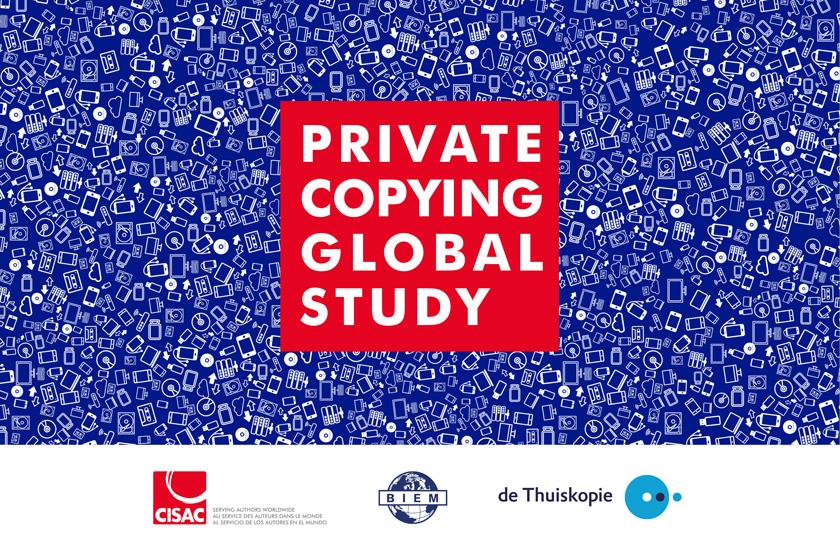New Private Copying Global Study shows potential for better remuneration of rightsholders

23 November 2020 – Private copying levies are a vital source of income for creators and rightsholders across the world. Yet they have an even greater potential if adequate legislation, proper application of the law and effective collection mechanisms are implemented.
A unique study published today provides the most complete and authoritative analysis to date of private copying systems around the world. The new Private Copying Global Study 2020 has been produced by CISAC, in partnership with BIEM and Dutch Society Stichting de Thuiskopie. It provides an overview of private copying systems and the legal environment in 194 countries and five continents. The new study also describes the legal and enforcement measures needed to maximise the income they raise for creators and rights holders. It also illustrates the potential economic benefits if levies are effectively implemented to cover digital devices.
In 2018, global collections of private copying levies for all rights holders totalled EUR 1,046 million. This includes EUR 367 million for authors, representing 3.8% of global authors’ collections.
Commenting on the new study, CISAC Director-General Gadi Oron says: “Private copying levies are an important source of income for rightsholders, with tremendous potential for growth. Our challenge is to promote the legal, enforcement and operational environment that would support further growth in this area. The new report offers invaluable insight and important guidance to decision makers for unlocking the economic potential of private copying levies, to the benefit of local creative communities.”
President of BIEM -Georg Oeller says: “Private copying has always been a key concern of BIEM members. Today’s publication is the result of a good cooperation between three complementary organisations in the defence, diffusion and acknowledgement of private copying around the world. We hope this report will help in further developing the scope of private copying, in terms of territories and equipment concerned, at the benefit of the creators by raising awareness of the authorities.”
Hester Wijminga, Director of Stichting de Thuiskopie, says: “In 1991 Thuiskopie started compiling information on the existing private copying systems in the world in order to learn and share best practises in collecting and distributing private copying remunerations on behalf of rightsholders. Now, so many years later, we are very pleased that in partnership with CISAC and BIEM we are able to present a global report on private copying. Sharing our knowledge and combining our expertise have resulted in the most extensive and complete work on private copying yet to be published.”
The 2020 Global Study combines and extends two previous reports, by Stichting de Thuiskopie (International Survey on Private Copying – Law and Practice 2016, in collaboration with WIPO), and by CISAC (the 2017 Global Private Copying Study). BIEM is also partnering in the new project to promote better awareness of the importance of private copying.
Numerous governments have focused on actions to improve private copying collections in recent years. In the Africa region, four new countries have recently started collecting private copy remuneration (Malawi, Morocco, Tunisia, and Cap Verde).
Currently the West African Economic and Monetary Union, supported by CISAC, is supporting the adoption of a Directive aimed at implementing private copying levies in 8 member states (Benin, Burkina Faso, Ivory Coast, Guinea Bissau, Mali, Niger, Senegal, and Togo). Positive developments are also taking place in Latin America and Asia.
The study – a summary
The common study is intended as an information tool for governments and policy makers, a reference for negotiations on fees and a source of data. It contains all the information that stakeholders need to know on private copying, from the legal framework to the practical implementation of private copying.
Using multiple data sources, the study examines the copyright laws of 194 countries in 5 continents and classifies, for each continent, the countries under 4 categories, from the lowest level of development to the most developed:
- Countries without a private copying exception
- Countries with a private copying exception but without a remuneration system
- Countries with a remuneration system but without collection and distribution mechanisms
- Countries with remuneration system and collection and distribution mechanisms
New elements include:
- Broader analysis: the new study covers both authors rights and neighbouring rights (for example, the figures of collections include both authors and neighbouring rights shares). Countries hitherto not included were also added.
- More data: detailed information on tariffs/levy and devices (media/equipment) subject to the levy, as well as private copying collections from 2015 to 2018
- More contextual analysis: the study outlines the model private copying system, from the legal background to its practical implementation:
o Tariff levy setting
o Liability
o Exemptions
o Collection process and distribution schemes
o Social and cultural deductions
- New economic analysis: the study includes a comprehensive economic analysis of private copying revenue trends in the last 4 years, with levy income estimates based on levies paid by 2 hypothetical households in different territories
- The economic analysis also includes an estimation of revenue potential per device for 7 targeted countries with potential future regulatory amendments (Bulgaria, Canada, Denmark, Japan, Korea, Mexico, Nigeria)
- European Case Law: the study contains an annex with the relevant European Court of Justice decisions on private copying.